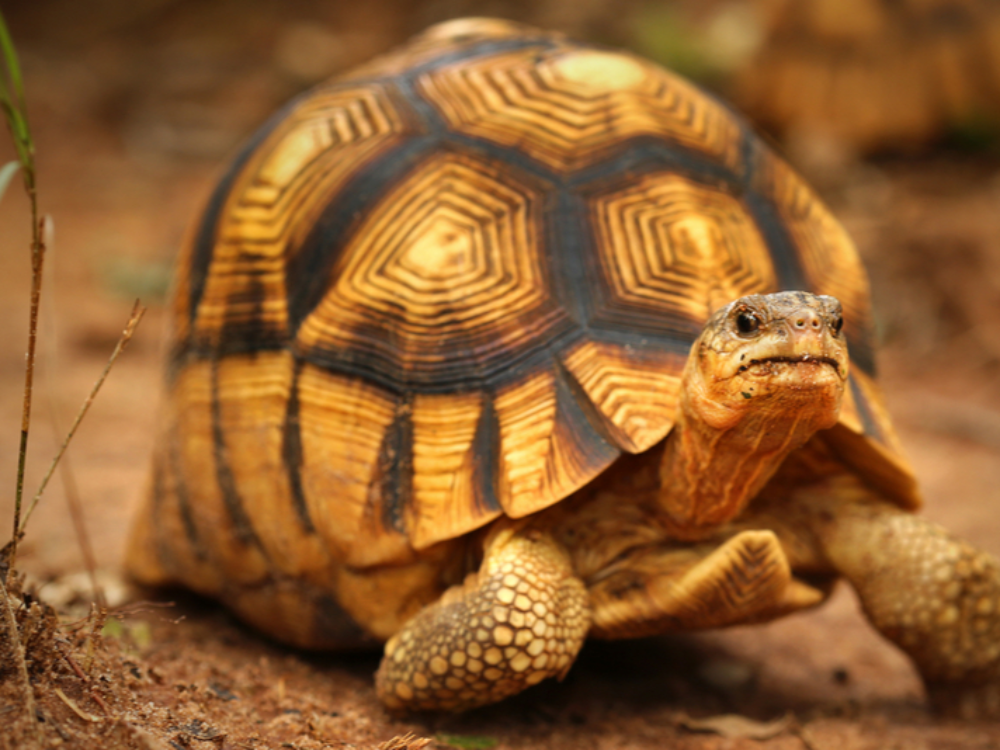The Ploughshare Tortoise (Astrochelys yniphora), also known as the Angonoka Tortoise, is one of the most critically endangered tortoises in the world. Native to the island of Madagascar, this species is renowned for its unique shell shape and striking appearance. Its plight has become emblematic of the challenges facing wildlife conservation in Madagascar, a biodiversity hotspot facing immense environmental pressures.
Physical Description of Ploughshare Tortoise
The Ploughshare Tortoise is easily identifiable by its distinctive shell, which features a prominent, plough-shaped front. This morphological trait is not just for show; it plays a crucial role in the tortoise’s behavior and interactions. The shell, or carapace, is high-domed and typically measures between 41 and 50 cm in length. Its coloration is a beautiful combination of golden yellow with dark brown or black radiating lines, creating a striking contrast that is unique among tortoises.
Habitat and Distribution
Historically, the Ploughshare Tortoise was found in the dry deciduous forests of northwestern Madagascar, particularly in the Baly Bay region. This area, characterized by seasonal climates and unique flora, provides the necessary environmental conditions for the tortoise. However, habitat loss due to agricultural expansion, logging, and frequent fires has significantly reduced its range. Today, the remaining wild populations are confined to a few small, protected areas.
Behavior and Diet
Ploughshare Tortoises are primarily herbivorous, feeding on a variety of grasses, leaves, and fruits available within their habitat. Their diet plays a vital role in maintaining the ecological balance of their environment, as they aid in seed dispersal and vegetation control. They are generally solitary animals, although they do exhibit social behaviors during the breeding season. Males can be territorial and will engage in combat using their plough-shaped plastron to flip rivals.
Reproduction and Lifespan of Ploughshare Tortoise
Breeding typically occurs during the wet season, from November to April. Females lay a small clutch of eggs, usually between 3 and 6, which they bury in the ground. Incubation lasts for about 220 to 250 days, depending on environmental conditions. Hatchlings are particularly vulnerable to predation and environmental threats, contributing to the species’ low reproductive success in the wild. In captivity, with controlled conditions, their survival rate improves significantly. Ploughshare Tortoises can live for more than 50 years, with some individuals reaching even greater ages under optimal conditions.
Conservation Status and Threats
The IUCN Red List classifies the Ploughshare Tortoise as Critically Endangered, with an estimated wild population of fewer than 400 individuals. Several factors contribute to their precarious status:
- Habitat Destruction: Deforestation and land conversion for agriculture have severely fragmented their natural habitat.
- Poaching: The illegal wildlife trade poses a significant threat. The tortoise’s rarity and beauty make it a target for collectors and the black market, despite legal protections.
- Invasive Species: Predation by introduced species such as rats, dogs, and pigs further diminishes the population, especially impacting eggs and hatchlings.
- Climate Change: Altered weather patterns and increased frequency of fires exacerbate the loss of suitable habitats.
Conservation Efforts for Ploughshare Tortoise
Conservationists have implemented several measures to protect and revive the Ploughshare Tortoise population. Key initiatives include:
Protected Areas: Establishing and maintaining protected reserves like the Baly Bay National Park, where human activities are controlled, and natural habitats are preserved.
Breeding Programs: Captive breeding programs, such as those conducted by the Durrell Wildlife Conservation Trust, aim to increase population numbers and reintroduce individuals into the wild.
Anti-Poaching Measures: Strengthening law enforcement and increasing patrols in critical habitats to deter poaching activities. Microchipping tortoises helps track and prevent illegal trade.
Community Engagement: Educating and involving local communities in conservation efforts fosters sustainable practices and creates alternative livelihoods that do not harm wildlife.
Research and Monitoring: Continuous research to understand the species’ ecology, behavior, and threats informs better management and conservation strategies.
Conclusion
The Ploughshare Tortoise stands as a symbol of both the unique biodiversity of Madagascar and the severe challenges faced by endangered species worldwide. Despite the dire circumstances, concerted conservation efforts offer a beacon of hope. Protecting this remarkable tortoise requires a multifaceted approach, combining habitat preservation, stringent law enforcement, community involvement, and scientific research. Through these efforts, there is a possibility that future generations will witness the thriving resurgence of the Ploughshare Tortoise in its natural habitat.










